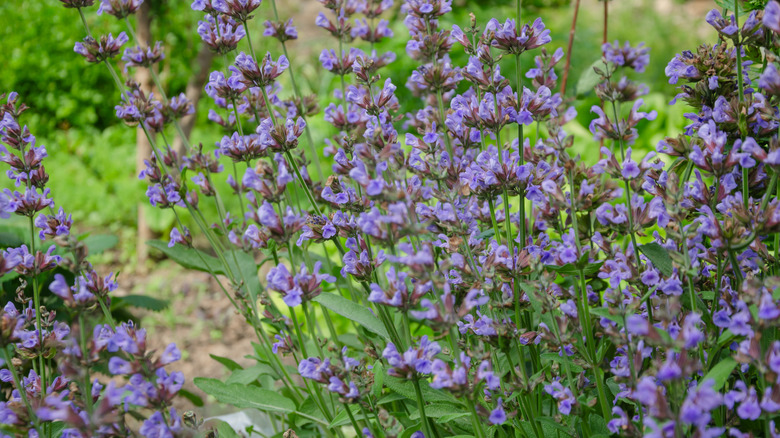Ripe, juicy tomatoes are a summertime treat, especially if you’ve taken the time to grow them yourself. To increase your chances of a bountiful harvest, consider growing a companion plant that repels pests, attracts pollinators, or both. There are a number of
herbs that make terrific tomato companions
, including garden sage (Salvia officinalis). First of all, sage deters flea beetles. These jumping pests munch on tomato foliage, sometimes disrupting plant growth and fruit production. Second, sage convinces helpful insects to hang out in your garden. This includes insects that pollinate the flowers of vegetable plants, aiding fruit production, and those that prey upon pests that can damage your cherished tomatoes. Best of all, sage is simple to grow in a range of sunlight and soil conditions.
Known for its purple flowers, which bloom early in the summer, sage is a magnet for bees, butterflies, and other pollinators. Bees love the tube-like shape of sage flowers, which they can easily crawl into in their quest to locate nectar. Sage also lures hover flies, which look like small bees but don’t sting. Before reaching maturity, hover flies eat as many aphids as they can find. They also prey upon thrips and other minuscule bugs that can bother your tomato plants. Once these little creatures can fly, they pollinate nearby flowers. Also known as syrphid flies and flower flies, hover flies may even help several plants in your vegetable garden make more seeds, including peppers and onions.
Read more:
The Herb You Should Consider Growing In Your Garden For Healthy Soil
Nurturing Sage That’s Planted Near Tomatoes

Caring for sage is pretty easy if you have a sense of what it needs. In general, this plant isn’t terribly fussy about soil and sunlight. It adores full sun but will accept partial shade. It likes loam but is nearly as happy in sandy soil. Just don’t let water pool around its roots. If your soil has a lot of clay in it, try mixing in some compost to improve its drainage. Also, avoid
one of the biggest mistakes gardeners make with sage
Overwatering should be avoided. It’s advisable to water this plant only when the top inch of its soil feels dry. Typically, fertilizing is not required for cultivating healthy sage; hence, apply it sparingly.
Garden sage acts as a perennial within USDA hardiness zones 4 to 10. Beyond this range, consider growing it in a container so you can bring it indoors when needed.
indoor herb garden
You can cultivate it in an outdoor container as well. This approach makes sense when you’re using sage to support your tomato plants. The reasoning behind this involves water requirements; sage prefers drier conditions compared to tomatoes. Typically, most tomato plants require frequent deep watering since consistent soil moisture leads to optimal growth. Conversely, sage thrives under dry conditions. Planting sage directly beside tomato plants could be problematic if the soil becomes overly moist, potentially causing the sage to perish. To ensure both benefit from each other’s presence, position your potted sage close by but avoid placing them in the same garden bed.
Liked this article? Sign up for expert home tips, DIY guides, and design inspiration from our newsletter.
House Digest newsletter
!
Read the
Original Article from House Digest
.


